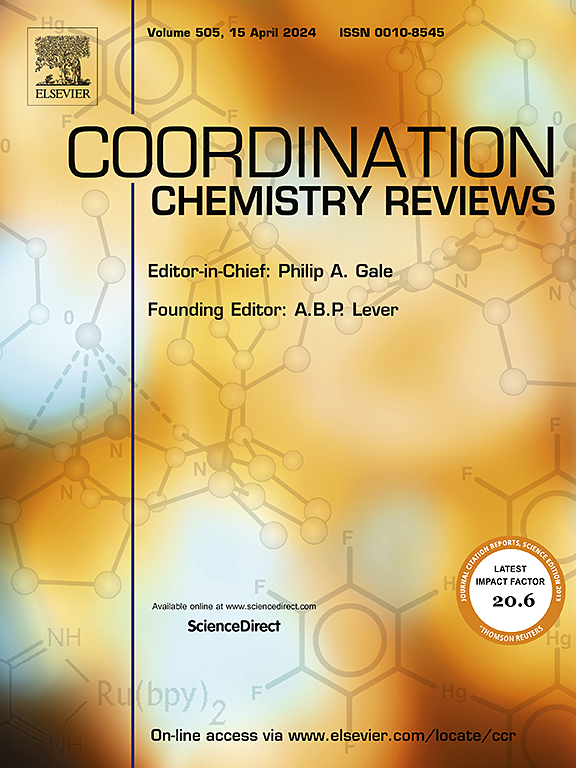MOF-derived nanomaterials: Transformative innovations for renewable energy and environmental sustainability
IF 23.5
1区 化学
Q1 CHEMISTRY, INORGANIC & NUCLEAR
引用次数: 0
Abstract
Metal-organic framework-derived nanomaterials (MOF-NMs) have revolutionized material science, offering unprecedented tunability in composition, porosity, and functionality. As versatile precursors, MOFs enable the synthesis of high-performance MOF-NMs, including metal oxides, metal nitrides, layered double hydroxides (LDHs), and carbon-based materials. By leveraging thermal treatments such as pyrolysis and calcination, along with chemical modifications of nitridation, phosphorylation, and sulfidation, these materials exhibit enhanced surface area, porosity, and catalytic activity. While extensive reviews have explored the synthesis and applications of MOF-NMs, a critical gap remains in systematically addressing the challenges that limit their large-scale deployment. This review highlights key synthesis routes of MOF-NM and the impact of critical parameters on their physicochemical properties. Despite their broad potential in catalytic applications such as HER, ORR, OER, and CO₂RR, the practical deployment of MOF-NM remains limited by issues of structural instability, poor scalability, and high production costs. This review discusses recent advancements aimed at addressing these challenges through innovative precursor design, material hybridization, and process optimization. By integrating insights into the transformative potential and challenges of MOF-NMs, this review serves as a roadmap for advancing these materials from laboratory research to real-world applications in sustainable energy and environmental technologies.

mof衍生的纳米材料:可再生能源和环境可持续性的变革创新
金属有机框架衍生的纳米材料(MOF-NMs)已经彻底改变了材料科学,在成分、孔隙度和功能方面提供了前所未有的可调性。作为多功能前驱体,mof可以合成高性能MOF-NMs,包括金属氧化物、金属氮化物、层状双氢氧化物(LDHs)和碳基材料。通过利用热解和煅烧等热处理,以及氮化、磷酸化和硫化的化学修饰,这些材料表现出增强的表面积、孔隙度和催化活性。尽管对MOF-NMs的合成和应用进行了广泛的研究,但在系统地解决限制其大规模部署的挑战方面仍然存在一个关键差距。本文综述了MOF-NM的主要合成路线以及关键参数对其理化性质的影响。尽管MOF-NM在HER、ORR、OER和CO₂RR等催化应用中具有广泛的潜力,但其实际应用仍然受到结构不稳定、可扩展性差和生产成本高等问题的限制。本文综述了旨在通过创新前驱体设计、材料杂交和工艺优化来解决这些挑战的最新进展。通过整合对MOF-NMs的变革潜力和挑战的见解,本综述可以作为将这些材料从实验室研究推进到可持续能源和环境技术的实际应用的路线图。
本文章由计算机程序翻译,如有差异,请以英文原文为准。
求助全文
约1分钟内获得全文
求助全文
来源期刊

Coordination Chemistry Reviews
化学-无机化学与核化学
CiteScore
34.30
自引率
5.30%
发文量
457
审稿时长
54 days
期刊介绍:
Coordination Chemistry Reviews offers rapid publication of review articles on current and significant topics in coordination chemistry, encompassing organometallic, supramolecular, theoretical, and bioinorganic chemistry. It also covers catalysis, materials chemistry, and metal-organic frameworks from a coordination chemistry perspective. Reviews summarize recent developments or discuss specific techniques, welcoming contributions from both established and emerging researchers.
The journal releases special issues on timely subjects, including those featuring contributions from specific regions or conferences. Occasional full-length book articles are also featured. Additionally, special volumes cover annual reviews of main group chemistry, transition metal group chemistry, and organometallic chemistry. These comprehensive reviews are vital resources for those engaged in coordination chemistry, further establishing Coordination Chemistry Reviews as a hub for insightful surveys in inorganic and physical inorganic chemistry.
 求助内容:
求助内容: 应助结果提醒方式:
应助结果提醒方式:


